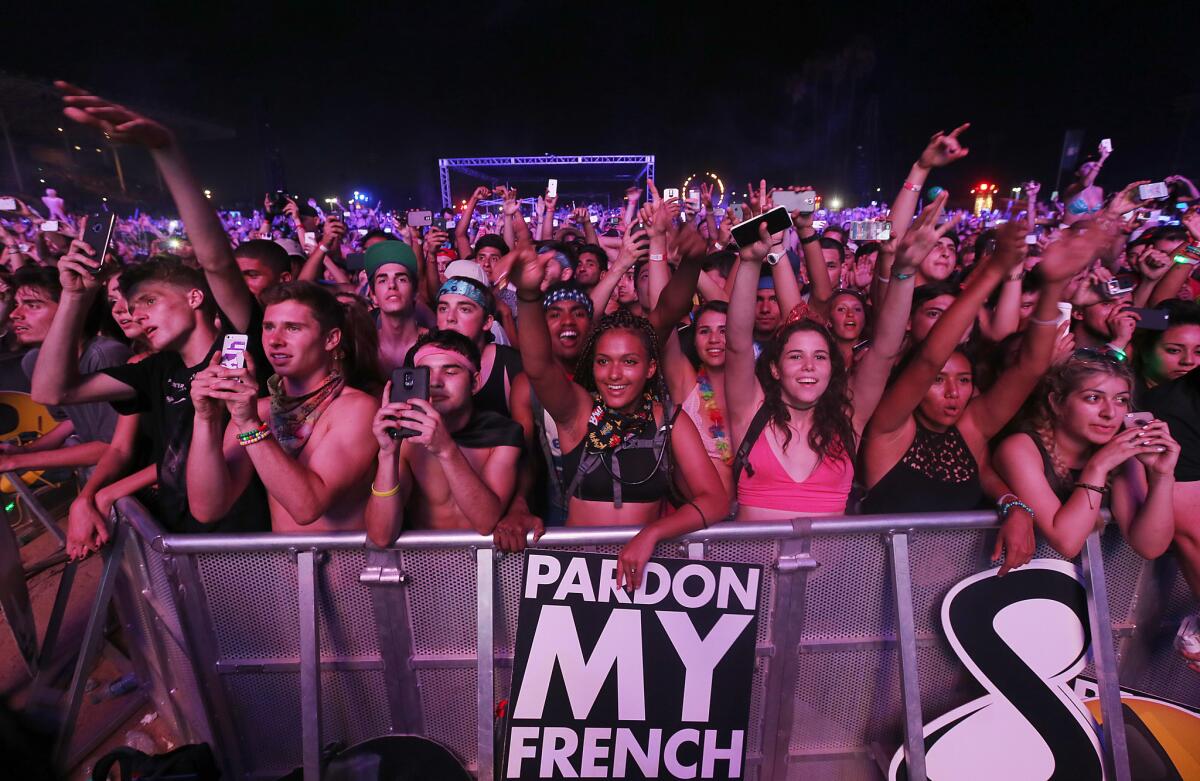Q&A: ER doctors: Drug-fueled raves too dangerous and should be banned

Fans during Hard Summer at the Fairplex in Pomona on Saturday, Aug. 1.
- Share via
Following the recent Hard Summer music festival marked by the suspected overdose deaths of two young women, several emergency room doctors are calling for an end to large raves in Los Angeles County.
Here’s some questions and answers to explain why several physicians think electronic dance music festivals are a risk to public health.
Q: Why are raves, or electronic dance music festivals, seen as so dangerous that some emergency room doctors want them banned?
A: They say there is something very different about raves that can cause nearby emergency rooms to be overwhelmed by severely ill, comatose and dying ravegoers.
Q: Why are raves different?
A: From the Aug. 1-2 Hard Summer music festival, managed by Live Nation Entertainment, 49 people were transported to emergency rooms by ambulance, according to the county and the worst-hit hospital, Pomona Valley Hospital Medical Center. Live Nation Entertainment said it was aware of only 37 transports.
Either way, that’s a big number, and highly unusual coming from a single event. The Pomona Valley hospital has 50 emergency room beds, and saw 28 rave patients over two days last weekend.
On the rave’s first day, about 65,000 attended, and on the second day, about 57,000 attended.
Q: How do these illnesses compare to illnesses from other events?
A: Dr. Philip Fagan Jr., emergency department director at Good Samaritan Hospital near downtown L.A., has had experience treating overdosing fans who went to raves held at the Los Angeles Memorial Coliseum more than five years ago. He said the big problem is how severely ill they can get.
“We don’t have as many people that are comatose and medically compromised” at other events, he said. “I don’t know anybody dying at USC football games from drugs and alcohol.”
Q: How sick can patients be coming from raves?
A: Some can be combative, requiring many staff members and police officers to hold them down, and need to be heavily sedated and continuously monitored. Some need to be admitted into intensive care.
When raves occurred at the Los Angeles Memorial Coliseum and Sports Arena more than five years ago, teenage patients came into nearby emergency rooms with convulsions and heart attacks. Those who survived sometimes suffered permanent brain damage, and with impaired speech and walking ability.
Q: Isn’t Ecstasy fairly safe as a drug? How can Ecstasy cause death?
A: There are several ways Ecstasy is dangerous. There is a myth that unadulterated, “pure” Ecstasy is safe. It is not.
1. Extremely high body temperatures, up to 109 degrees
The drug, which is also known as MDMA or Molly, can cause a sharp increase in body temperature, or hyperthermia, that can lead to death, according to the U.S. Drug Enforcement Administration.
Ecstasy tablets can also contain methamphetamine and cocaine.
Dr. Marc Futernick, medical director for emergency services at Dignity Health California Hospital Medical Center, said he has seen overdosing ravegoers suffering temperatures as high as 109 degrees -- a temperature so high that body organs can start to fail.
It’s “the kind of temperatures that there’s no other way to describe it other than it will melt your organs and do damage to your organs to the point you will die,” Futernick said.
A Los Angeles Times review of coroner reports of people who died after attending raves and taking Ecstasy found several people who had temperatures of 107 and 108 degrees.
2. Drinking too much water, causing sodium levels to fall
Ecstasy can also cause extreme thirst. While dehydration can pose a problem, so can drinking too much water, causing sodium levels to crash, and causing a problem known as hyponatremia. That has caused those who take Ecstasy to get into a lengthy seizure that makes it hard to breathe. Without enough oxygen going to the brain, this has put people into fatal comas, Futernick said.
The 15-year-old girl who fatally overdosed on Ecstasy in 2010 at the Electric Daisy Carnival at the Los Angeles Memorial Coliseum suffered from abnormally low sodium levels and arrived at the emergency room in a coma, Futernick said in 2010. According to a Los Angeles Times account from 2010, the girl quickly drank water after getting hot at the event, and then passed out.
3. Kidney failure
A third problem is that the drugs can cause the breakdown of muscle into a chemical that damages the kidneys, said Dr. Brian Johnston, chair of the emergency medicine department at White Memorial Medical Center. Known as rhabdomyolysis, such Ecstasy-induced kidney failure can be fatal, according to a study published in the Journal of Emergency Medicine in 2009.
Johnston recalled one teenager who came in with a temperature of 108 degrees and in convulsions. The teen spent 28 days in the intensive care unit and left the hospital without working kidneys, and had to be on dialysis.
“I have seen 16-, 17-, 18-year-old kids with heart attacks. You don’t see that from other events. This is a different animal,” Johnston said.
Futernick disagrees with the idea that Ecstasy is a fairly safe drug if, as one argument goes, many people at raves can take it and not become severely ill or die.
“Not everybody who drives drunk crashes their car. Should we let everyone drive drunk?” Futernick said.
Q: Why don’t these emergency room doctors think there might be a way to make raves safer?
A: Raves at mainstream venues have been going on for quite some time, and despite huge efforts made at drug detection, the number of overdoses can still overwhelm emergency rooms.
“We’ve seen this all around the nation; in L.A., it popped up in Chicago, in San Francisco, in New York, and it’s the same thing,” Futernick said.
“Maybe it’s the lack of supervision … maybe it’s poor security at the door, maybe it’s the culture of that’s what you do at a rave -- the only reason you go and listen to this electronic music is when you’re really high on Ecstasy,” he said. “You just can’t ignore, at the end of the day, that we see these happening at these events and we don’t see them elsewhere.”
Q: What do these doctors say about the argument that it’s better to have these events closer to the city – so rave fans can get medical attention if they need it?
A: These doctors don’t agree. Part of the problem is the enormous size of the events, making it hard to identify someone who is becoming seriously ill.
“If people get together and take drugs, alcohol, or whatever and dance in a small group, they knew each other, they look out for each other,” said Dr. Brian Johnston, chair of the emergency medicine department at White Memorial Medical Center.
“But in a situation like this, most people who are there don’t know each other, they come from far away, they don’t look out for each other,” he said. “And as they do the drugs, they become less observant, less capable of helping someone, less capable of recognizing someone who is in trouble.”
Fagan also disagreed with the argument.
“So if you’re going to have a whole bunch of people shooting each other, it’s better to have it in a city than out somewhere where they can’t get care?” Fagan asked. “It’s begging the question as to whether or not they should have” these events.
Q: Is there something about the event itself that also poses a particular risk?
A: These events can last for 12 hours or more, and there may be a problematic combination of marathon dancing, increasing body heat, dehydration and taking drugs “that give you a lift and give you a sense that everything is OK,” Johnston said.
Q: What have other venues done about raves?
A: Some venues no longer host raves, such as the Los Angeles Memorial Coliseum and the state-run Cow Palace near San Francisco. Others, often farther away from the city center, permit them, like the Los Angeles County fairgrounds and the San Manuel Amphitheater in Devore, which is owned by San Bernardino County and managed by Live Nation Entertainment.
Q: What policy recommendations do the doctors have?
A: These doctors say they support the idea of a moratorium on raves on county-owned property, which is being considered by the Los Angeles County Board of Supervisors.
They said officials should go further and ban them because of the risk to public health.
“If the county wants to make money while people are dying and medically compromised ... they should come out and say it,” Fagan said.
Q: In 2013, the last day of the three-day Electric Zoo rave in New York City was canceled after two ravegoers died from overdoses. What did officials learn from that rave?
A: New York City health officials found a “much higher” death rate at the rave compared to the death rate from unintentional poisonings in New York City in 2012 from psychoactive substances of those aged 15 to 34.
The death rate at Electric Zoo was 2.5 out of 100,000 person-days. For the death rate from unintentional poisonings from psychoactive substances in a comparable age group, it was 0.02 out of 100,000 person-days, according to a report published in the U.S. Centers for Disease Control and Prevention’s Morbidity and Mortality Weekly Report.
Q: What are the details on those who fatally overdosed at Electric Zoo?
A: Of the two who died, one had Ecstasy in his system, and the other had Ecstasy and methylone, a designer drug similar to Ecstasy.
The researchers identified a total of 22 ravegoers who were later transported to emergency rooms, including the two who died. Here’s some more numbers about these 22:
- Number who had a temperature above 102: 4
- Number who had abnormally fast heart rate: 14
- Number who had low sodium: 5 (out of 18 tested)
- Number who had acute kidney injury: 4 (out of 17 tested)
- Number who had breakdown of muscle: 7 (out of 7 tested)
- Number who had a seizure: 6
- Number who had to be put on a ventilator: 5
- Number admitted into intensive care: 5
Q: What did New York City do about raves after the 2013 deaths?
A: New York City health officials created recommendations, according to the CDC report. They included:
- Employing strategies to reduce excess alcohol consumption,
- Prohibiting the sale of mixed energy-alcohol drinks,
- Providing readily accessible no-cost drinking water,
- Identifying impaired patrons and bringing them to medical attention (e.g., by using roaming teams and visual inspections of attendees at entrances and exits),
- Developing a plan to prevent heat-related illness for summer events,
- Distributing harm-reduction messages in advance of and during events;
- Implementing a surveillance system to rapidly identify adverse health events including reporting [emergency department] transports to the [New York City Department of Health and Mental Hygiene] every four hours.
Q: How did that effort fare when the rave returned in 2014?
A: According to the report, the event’s promoters started roaming teams of peer volunteers of one per 500 attendees, denied admission to ticket holders visibly under the influence of drugs or alcohol, reduced the festival’s hours to lessen the chance of heat illness, and required viewing of a Public Service Announcement warning about the danger of drug intoxication before entering the event.
That year, 10 were people transported to the emergency room after attending the rave. They included two severe cases and one death, which was blamed on methamphetamine.
“The death occurred several hours after the event had closed for the day; future mitigation strategies might include enhanced supervision of patrons leaving the venue,” the report said.
Q: What kind of additional research do health officials want?
A: Health officials didn’t get information about people treated at the rave. “It is known that a substantial number of persons were treated on-site and that certain persons would likely have been transported to [emergency departments] had medical treatment tents not been available,” the authors said.
Q: What does Live Nation Entertainment, the promoter of the Hard Summer music festival, say?
A: The company, one of the world’s largest concert and ticketing conglomerates, which recorded $4.7 billion in concert revenue in 2014, said it is cooperating with the county’s request for an investigation. It also said the festival plan was designed with direct input and approval from all county and government agencies as well as the fairground’s management.
The company said it set up two primary medical tents at the Los Angeles County fairgrounds last weekend, and paid for three emergency room doctors, 13 registered nurses and 63 emergency medical technicians. It deployed drug-sniffing dogs, airport-style bag checks, pat-downs of guests and “amnesty boxes” where guests could surrender drugs.
Q: What does the Los Angeles County fairground management say?
A: Fairground spokeswoman Renee Hernandez said in a statement:
“Although we are confident in the security and other support we provide all events at Fairplex, including those, like Hard, owned and managed by third-party event companies like Live Nation, we support any call for enhanced safety.
“We will … work closely with the county to implement any potential new procedures intended to create an even safer and more secure guest environment.”
Q: What are fans of raves saying?
A: One petition being circulated by electronic dance music festival fans says:
“We believe ‘raves’ offer positive benefits to society, encouraging creativity, providing jobs to local artists and cultivating the values of empathy, peace and unity amongst event attendees who then carry those values back into our local communities. We believe working with the Electronic Music Alliance, L.A. can help make these events the most positive experience by using our expertise and best practices to develop better ways to protect and encourage responsible behavior amongst patrons.”
Follow me on Twitter: @ronlin
ALSO:
How to stay healthy at those grueling music festivals
Vaping shops say FDA regulation could put them out of business
One of two women who died of apparent overdose at rave ID’d as UCLA student
More to Read
Sign up for Essential California
The most important California stories and recommendations in your inbox every morning.
You may occasionally receive promotional content from the Los Angeles Times.











